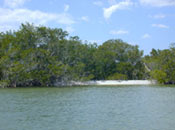Modeling Hydrologic Flow and Vegetation Response across the Tamiami Trail and Coastal Watershed of Ten Thousand Islands NWR
|
Project Investigators:
Thomas W. Doyle, Ken W. Krauss
Project Personnel: Ehab Meselhe, Rebecca J. Howard, Eduardo Patino, Terry Doyle, Emab Habib Project Start Date: 2006 End Date: 2010 Recent Funding: (FY07) ENP CESI, USGS GE PES, (FY06) ENP CESI, USGS GE PES |
| Summary |
| The primary goal of this study is to monitor and model surface water, groundwater, and evapotranspiration fluxes across a major hydrological barrier in south Florida (U.S. Hwy. 41, Tamiami Trail), and across the oligohaline-estuarine gradient of TTINWR. |
There is a critical need for current hydrologic and vegetation data to understand current processes and relations
controlling hydroperiod, salinity, and plant succession under pre-project conditions and climate in order to build models and to predict how increasing freshwater flow and sea-level rise will impact future habitat quality and distribution. This study will establish a stratified network of gaging stations to monitor continuous water levels and salinity conditions associated with vegetation type and growth response and to produce a hydrodynamic model to predict changes in hydroperiod and salinity under different rates of freshwater inflow, pre- and
post-project. Gaging stations will be surveyed to vertical datum to create a digital elevation model of both land and water surface that can be used to calibrate hydroperiod and salinity relations that control vegetation growth and succession. Model applications will be extended to predict vegetation migration and succession under changing freshwater delivery regimes and changing sea-level under projected climate change. Refuge personnel will benefit from the repository of observational data and interactive models for adaptive management
purposes. This research will record the rate and stage of water flow under varying climatic conditions (e.g., wet and dry season) across the coastal margin of TTINWR prior to and following implementation of hydrologic restoration outlined for the Picayune Strand Restoration Project (and Southern
Golden Gate Estates Hydrologic Restoration). Overall project tasks and objectives include: gaging
hydrologic conditions, surveying ground and water elevations, correlating hydroperiod and plant associations, monitoring intra-annual growth response to climate and hydrology, and modeling hydrologic coupling and vegetative
succession.
Work Plans
Project Summaries
Metadata
- Modeling hydrologic flow and vegetation response across the Tamiami Trail and coastal watershed of Ten Thousand Islands NWR (project metadata)

